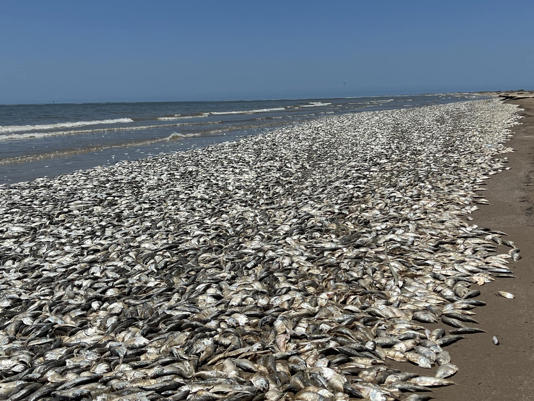All i can say..... the smell must ........ smell like a bangkok brothel .......i hate the smell of fish ....rotting fish .......i cannot even imagine .......this alagae is bad news .......but even more bad news is living in and a round the place .......no thanks .....somone has to get rid of them ......and make some sort of oil .......sustainable oil ........
Thousands of dead fish have washed up on a once-idyllic Texas beach, baffling beachgoers and covering its shores with miles of carcasses
- Thousands of dead fish washed up in southeast Texas over the weekend, covering beaches in carcasses.
- Local officials said the fish were killed by low oxygen levels in the water.
- Footage shows the carcasses blanketing ocean shallows and entire beaches for miles.
Thousands of dead fish washed up on the Texas shoreline near Houston this weekend, confusing beachgoers and a team of scientists who were there to study beach sediment.
Marine carcasses stretched for miles along the Texas Gulf Coast, blanketing both shores and shallows.
The fish were killed by low oxygen levels in the water brought about by rising summer temperatures, according to a Saturday Facebook post by the parks department for Quintana Beach County, a beachfront campground in the area.
The park, popular with tourists and camp goers, fielded dozens of questions online from confused visitors.
Most of the dead fish were menhaden, a small fish often used for bait, Quintana Beach County's Facebook account said in a post on Saturday.
"When water temperature rises above 70 degrees Fahrenheit, it becomes hard for menhaden to receive enough oxygen to survive," the post read. "Shallow waters warm more quickly than deeper, so if a school of menhaden are trapped in the shallows as the water begins to heat, the fish will start to suffer from hypoxia."
Six miles southwest of Quintana Beach County, footage showed thousands of dead fish covering swathes of the ocean off Bryan Beach. One fisherman reported seeing the dead fish 10 miles away from shore, Quintana Beach County said.
Related video: Why Hundreds Of Dead Fish Washed Ashore In Texas (The Weather Channel)
 The Weather Channel
The Weather ChannelJulia Wellner, a glacial marine geoscientist at the University of Houston, tweeted on Sunday that she and a team of sedimentologists visiting the shore were "baffled" to find the dead fish.
"Went for miles. Low oxygen sure but why here and now? Why this dramatic? Scary future," Wellner wrote.
By Sunday evening, crews had mostly cleared the pedestrian beach at Quintana, according to the beach county.
The carcasses were already to rotting and deteriorating by then, with some fish being reduced to "shredded skeletons," the county added.
It said the Texas Parks & Wildlife Kills and Spills Team had confirmed that low oxygen levels in the water were the cause of death for the fish.
"There was NO evidence of a chemical release of any kind, so please put those theories to rest and do not spread misinformation," Quintana Beach County wrote.
In March, millions of fish were thought to have died in a river in New South Wales, Australia, due to low oxygen levels. The dead fish had washed up after a heatwave swept across the region.
Waves of dead fish have sometimes appeared on the US coast because of algae blooms when bacteria toxic to fish spread rapidly. While algae blooms can occur naturally throughout the year, they've grown more frequent and severe due to the climate crisis, per research from the University of Florida.

1 of 16 Photos in Gallery©Jace Tunnell/Mission-Aransas National Estuarine Research Reserve
Barnacle-encrusted dolls, a message in a bottle, and a giant mermaid: Photos show the bizarre beach debris headed to auction in Texas
- Every year, the Mission-Aransas Reserve in Texas holds an auction to sell debris found on its beaches.
- Everything from creepy baby dolls — so many creepy baby dolls — to mermaids and glass bottles wash up.
- This year's auction is on Saturday, May 20.
You might have heard about the absurd number of dolls that washed up on a Texas beach last year.
And, in case you're concerned about what happens to them, don't worry — they'll soon be finding homes.
Once again, the Mission-Aransas Reserve is auctioning off the dolls and other debris found along its 40-mile stretch of beach. This year's auction will take place on Saturday, May 20.
Here's what's for sale this year, from a message in a bottle and a giant mermaid to multiple baby dolls covered in barnacles.




No comments:
Post a Comment